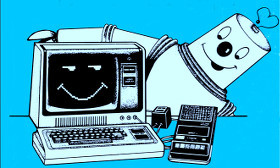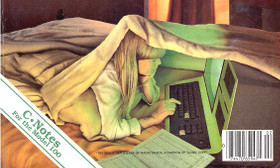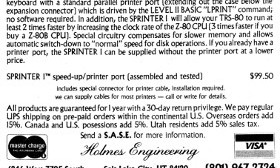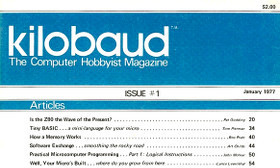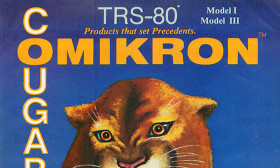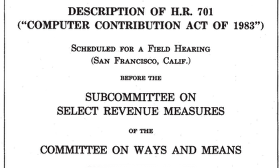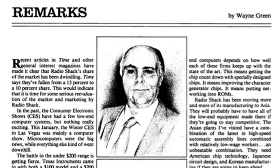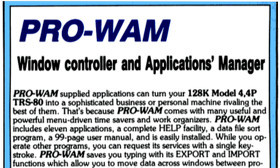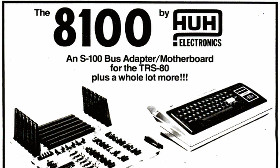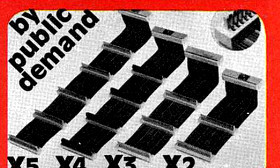BASIC Computer Games (ISBN 0-89480-052-3) was the first and most popular of a category of books containing games written in BASIC for typing into a computer. It was also the first computer book to sell more than a million copies. Many people took their first steps as programmers by typing in and modifying the programs in this book.
BASIC Computer Games and its sequel, More BASIC Computer Games (also known as BASIC Computer Games Volume II) were created by David Ahl, the founder and publisher of Creative Computing magazine. Both books were very popular and were translated into German (BASIC Computer Spiele and BASIC Computer Spiele: Band 2), French (Jeux D’Ordinateur en BASIC and Nouveaux Jeux D’Ordinateur en BASIC), and a three-volume Danish edition (BASIC Computerspil). Both BASIC Computer Games and More BASIC Computer Games had TRS-80 specific editions that were sold both by Radio Shack and Creative Computing Press.
(Read more...)
For three years starting in 1982, the TRS-80 magazine 80 Micro held a contest to encourage young people to program. It was known as the “80 Micro Young Programmer’s Contest.” Anyone under the age of 18 could submit a program for a chance at winning prizes. 80 Micro published the winning contest entries in the February issue each year.
The entries, which numbered over 200 the first two years, were judged by the 80 Micro editorial staff based on five categories: programming elegance, documentation, originality, error-trapping, and usefulness. Most of the winning entries were written for the TRS-80 Model I and III, but there were also several for the Color Computer, and even one each for the Model II, Model 4, and Model 100.
(Read more...)
The Holmes Sprinter was a family of speed-up boards for the TRS-80 Model I and III. They were created and sold by Holmes Engineering, Inc., a company responsible for many hardware add-ons for the TRS-80, such as the Expansion Mainframe, the VID-80, and the Internal Memory. The Sprinter models were probably the most popular speed-up boards available for the Model I and III.
The Sprinter I for the TRS-80 Model I was introduced in late 1981. It cost $99.50, which was more expensive than its primary competitor, the Archbold Speedup Board. However, the Sprinter I had one big advantage over the Archbold Speedup Board: it could be installed with no soldering at all. Installation required just a few steps:
(Read more...)
Kilobaud Microcomputing was a hobbyist computing magazine that began in 1977. It was created by Wayne Green, who was known for publishing the magazines 73, BYTE, and later 80 Microcomputing. Kilobaud Microcomputing was aimed more at the beginning computer hobbyist than other similar magazines. It is perhaps best known for spinning off 80 Microcomputing, the most popular TRS-80 magazine.
The magazine was originally named Kilobaud when it began in 1977. That changed to Kilobaud Microcomputing by the January 1979 issue. The word “Kilobaud” on the cover became smaller and disappeared entirely in 1982. The magazine was then called Microcomputing until it ended in 1984.
(Read more...)
The Omikron Mapper was the first (and probably most popular) CP/M hardware add-on for the TRS-80 Model I and Model III. It allowed unmodified CP/M programs to run on a TRS-80, something not normally possible. The Omikron Mapper was introduced in 1979 by Omikron Systems, a Berkeley, California company run by George Gardner.
Omikron Systems sold three versions of the Omikron Mapper from 1979 to 1984:
- The original Omikron Mapper I was for the Model I. In 1979, it cost $169.00 for a version that could use 5 1/4" floppy drives. A version that could use 8" drives cost $199.00.
- The Omikron Mapper II was a data separator that allowed a Model I with Expansion Interface to run CP/M using a combination of 5 1/4" and 8" drives. In 1980, it cost $99.00. Omikron originally bundled the Mapper I as part of the Mapper II, but later sold them separately. In addition to CP/M, NEWDOS/80 could also use the Mapper II to access 8" drives.
- The Omikron Mapper III was for the TRS-80 Model III. Unlike the Mapper I, it only supported 5 1/4" drives. It cost $199.00 in 1983.
(Read more...)
Almost as soon as microcomputers became widely available to consumers in 1977, there were efforts to place them in classrooms. Both Apple (with the Apple II) and Radio Shack (with the TRS-80 Model I) concentrated heavily on education and school sales. By 1982, it was unclear which company had the edge when it came to computers in schools. There was a great deal of conflicting information, some showing Apple ahead and some with Radio Shack as the leader. As late as 1985, Radio Shack claimed that there were “more TRS‑80 computers in America’s schools than any other brand.”
Either way, both companies were heavily involved in the education market. At the time, 25% of Apple’s revenue came from educational sales. Both companies had compelling reasons to get their computers in schools and build their brand awareness among schoolchildren. Beyond those reasons, people at both companies felt that computers in schools were the future. In a 1995 interview with the Smithsonian Institution, Apple co-founder Steve Jobs recalled their plan to make that happen:
(Read more...)
“80 Remarks” was a column that ran in 80 Microcomputing from the first issue in January 1980 until September 1983. It was written by Wayne Green, the publisher and founder of 80 Microcomputing. The column name was shortened to just “Remarks” in October 1982.
Wayne Green published several magazines at the time and wrote a different column in each. His column was “Never Say Die” in 73, “Publisher’s Remarks” in Kilobaud Microcomputing, “Off Color” in Hot CoCo, “Hot Cider” in inCider, and “80 Remarks” in 80 Microcomputing.
Wayne Green set the tone for “80 Remarks” with his first column:
First, I want to make it clear that this magazine is not connected with Radio Shack or Tandy. I call ‘em as I see ‘em and don’t pull the punches. Where Radio Shack deserves credit, they’ll get it. Where I think they are screwing up, I’ll be blunt about that. I don’t ask that you like me–that’s your problem, not mine. I like you and I will be working for your best interests… and so will the magazine.
(Read more...)
PRO-WAM (also known as PRO-NTO) is a collection of pop-up tools for LS-DOS/TRSDOS 6 on the TRS-80 Model 4. It was written by Karl Hessinger and Roy Soltoff and cost $59.95 when it was introduced in December 1984.
PRO-WAM was one of the few programs to require a Model 4 expanded to a full 128K of memory. In my opinion, it was one of the best uses of the extra memory and one of my favorite Model 4 utilities.
PRO-WAM was described in advertisements as a “Window Controller and Applications Manager.” It was inspired by the Borland program Sidekick, a terminate and stay resident personal information manager that was very popular at the time on the IBM PC. (PRO-WAM was also similar to Monte’s Window, written by Jim Stutsman, which was only available for Montezuma Micro CP/M.) Like Sidekick, PRO-WAM provided a set of simple, but useful, tools that could be popped up over a running program.
(Read more...)
After the Radio Shack TRS-80 Model I was introduced in 1977, many companies were said to be developing an interface to allow the Model I to use the wide selection of S-100 hardware available at the time. HUH Electronics of San Mateo, California was one of the few companies (if not the only) to actually release a S-100 interface. Their Model 8100, introduced in November 1978, had six slots to allow up to six S-100 devices to be connected to the Model I.
The S-100 bus standard was created by MITS in 1975 for their Altair 8800 computer. The Altair 8800 was designed with one mainboard with five 100-pin edge connectors. These connectors were used to attach the CPU, memory, and other peripherals to the Altair. These connectors followed a standard that became known as the “Altair bus.” Many people started creating and selling hardware designed to plug into the Altair bus. Competing computers, such as the IMSAI 8800, also used the standard, but under the name “S-100 bus.”
(Read more...)
The TRS-80 Model I, unlike some other contemporary computers, offered no way to install expansion cards internally. The Model I did have an expansion bus connector which allowed users to attach external hardware devices, such as the Radio Shack Expansion Interface. But the single connector meant that only one hardware device could be attached to a Model I at a time.
The Expandabus from Alpha Products, introduced in 1981, provided a way for TRS-80 Model I owners to connect multiple devices to the expansion bus, allowing up to five devices to be connected to a single Model I.
The Expandabus was similar to the T-Buss, which was one of the first TRS-80 items Alpha Products sold. The T-Buss cost $80.00 and allowed five devices to be connected to the Model I. The Expandabus was more flexible and available in four versions:
- the X2-40 for $29.00, which could connect two devices.
- the X3-40 for $44.00, which could connect three devices.
- the X4-40 for $59.00, which could connect four devices.
- the X5-40 for $74.00, which could connect five devices.
(Read more...)
